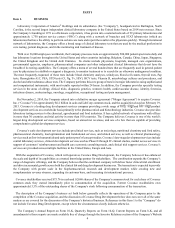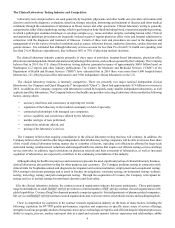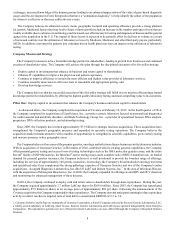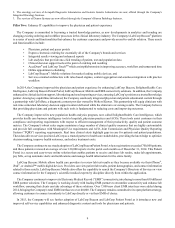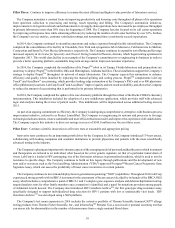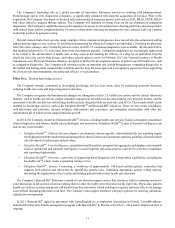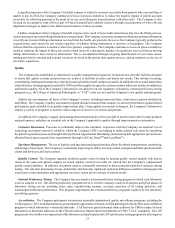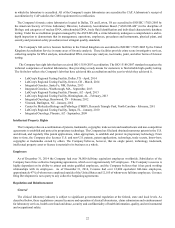LabCorp 2014 Annual Report Download - page 14
Download and view the complete annual report
Please find page 14 of the 2014 LabCorp annual report below. You can navigate through the pages in the report by either clicking on the pages listed below, or by using the keyword search tool below to find specific information within the annual report.12
Covance Integration Strategy
In addition to remaining committed to its core mission of being a trusted knowledge partner for stakeholders, leading to growth
in its businesses and continued creation of shareholder value, the Company intends to continue working towards integrating
Covance Drug Development into its operations in order to capitalize on the enhanced capabilities of the combined company. The
Company has identified three strategic opportunities as its top priorities during the initial phases of this integration: (i) deliver
faster clinical trial enrollment; (ii) become the partner of choice to develop and commercialize companion diagnostics; and (iii)
enhance Phase IV clinical trial experience and post-market surveillance.
Deliver faster clinical trial enrollment. Utilizing the Company’s database of more than 70 million unique patient records along
with Covance Drug Development’s investigator database and analytic capabilities is expected to enable faster, higher-quality
clinical trials, reduce trial cycle time, help to eliminate non-viable sites (the presence of which can delay recruitment), reduce costs
and increase revenue for biopharmaceutical company clients.
Partner of choice to develop and commercialize companion diagnostics. As noted above, companion diagnostics will become
increasingly important, and currently there are dozens of drugs in Phase III development that will require companion diagnostics. By
combining Covance Drug Development’s strength in central laboratory and early-stage clinical development with the Company’s
strength in test commercialization, the combined drug development business will be able to offer comprehensive, end-to-end
support for companion diagnostic development.
Enhance Phase IV clinical trial experience and post-market surveillance. About 30 percent of Phase IV clinical trial patients
drop out due to inconvenient trial procedures and the limited number of trial sites. The Company believes that its 1,750
PSCs, approximately 5,000 phlebotomists in physician offices and convenient patient web portal for scheduling can improve the
Phase IV clinical trial patient experience. The Company also believes that its infrastructure will serve another important function,
allowing the combined organization to collect post-approval safety data on new drugs. Since 1972, more than 25 approved drugs
have been withdrawn from the market, the vast majority due to toxicity. The Company believes that Covance Drug Development’s
analytics capabilities can identify early safety signals, avoid extensive recalls, and find genotypical characteristics of patients who
experience adverse drug reactions so that the drug can be given to patients for whom it is safe. The combined drug development
business is also expected to be able to use these capabilities to assist biopharmaceutical companies in identifying new indications
for their drugs through post-market studies.
Laboratory Testing Operations and Services
The Company has a national network of primary testing laboratories, specialty testing laboratories, branches, PSCs and STAT
laboratories. A branch is a central facility that collects specimens in a region for shipment to one of the Company's laboratories
for testing. A branch is also frequently used as a base for sales and distribution staff. Generally, a PSC is a facility maintained by
the Company to serve the patients of physicians in a medical professional building or other strategic location. The PSC staff collects
the specimens for testing if requested by the physician. Most patient specimens are collected by the customer's staff. The specimens,
and any accompanying documents including test request forms if the test order was not placed electronically, are collected from
customer locations, including in-office phlebotomists, or PSCs and sent, principally through the Company's in-house courier
system (and, to a lesser extent, through independent couriers), to one of the Company's primary testing laboratories for testing.
Test requests are completed by the client or transcribed by a Company patient service technician from a client order to indicate
the tests to be performed and provide the necessary billing information. Some of the Company's PSCs also function as STAT labs,
which are laboratories that have the ability to perform certain core tests and report results to the physician quickly.
Each specimen and related request form is checked for completeness and then given a unique identification number. The unique
identification number assigned to each specimen helps to ensure that the results are attributed to the correct patient. The test request
forms are sent to a data entry operator who ensures that the necessary testing and billing information is entered. Once this information
is entered into the software system, the tests are performed and the results are entered through an electronic data interchange
interface or manually, depending upon the tests and the type of instrumentation involved. Most of the Company's automated testing
equipment is connected to the Company's information systems. Most core testing is completed by early the next morning and test
results are in most cases electronically delivered to clients via LabCorp Beacon, smart printers, personal computer-based products
or electronic interfaces.




